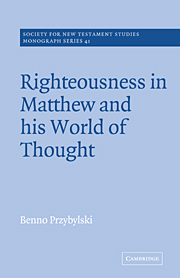Book contents
- Frontmatter
- Contents
- Preface
- Abbreviations
- 1 The problem of the meaning and significance of the Matthaean concept of righteousness
- 2 Tsedeq, tsedaqah and tsaddiq in the Dead Sea Scrolls
- 3 Tsedeq, tsedaqah and tsaddiq in the Tannaitic literature
- 4 The meaning of dikaiosynē, eleēmosynē and dikaios in the Gospel of Matthew
- 5 The relative significance of the concept of righteousness in the Gospel of Matthew
- 6 The provisional function of the Matthaean concept of righteousness
- Notes
- Bibliography and system of references
- Index of passages cited
- General index
2 - Tsedeq, tsedaqah and tsaddiq in the Dead Sea Scrolls
Published online by Cambridge University Press: 18 December 2009
- Frontmatter
- Contents
- Preface
- Abbreviations
- 1 The problem of the meaning and significance of the Matthaean concept of righteousness
- 2 Tsedeq, tsedaqah and tsaddiq in the Dead Sea Scrolls
- 3 Tsedeq, tsedaqah and tsaddiq in the Tannaitic literature
- 4 The meaning of dikaiosynē, eleēmosynē and dikaios in the Gospel of Matthew
- 5 The relative significance of the concept of righteousness in the Gospel of Matthew
- 6 The provisional function of the Matthaean concept of righteousness
- Notes
- Bibliography and system of references
- Index of passages cited
- General index
Summary
Introduction
This study of the words connected with the root ts-d-q in the Dead Sea Scrolls is not an end in itself but is undertaken for the purpose of providing a basis of comparison with the use of the concept of righteousness in the Gospel of Matthew. In the study of the Gospel of Matthew, stress will not only be placed on determining the meaning of terms such as dikaiosynē and dikaios but also on determining the overall significance of the use of the concept of righteousness in this gospel. In order to provide a valid basis of comparison, the twofold approach of determining specific meanings of various terms and their overall significance must also be applied to the study of the words connected with the root ts-d-q in the Dead Sea Scrolls.
In order to make a valid comparison, however, it is not sufficient merely to apply methodological principles consistently to various bodies of literature. It is of the utmost importance that the methodological principles be applied to bodies of literature which represent compatible literary categories. Specifically, the question must be asked whether the Gospel of Matthew can be compared to the Dead Sea Scrolls as a whole or whether distinctions must be made amongst the Dead Sea Scrolls. In other words, the question of the homogeneity of the Dead Sea Scrolls must be faced.
The New Testament discipline of Redaktionsgeschichte has shown that the Gospel of Matthew is composed of various traditional materials which were brought together by a redactional process, the final stage being carried out by a specific individual or a group of persons.
- Type
- Chapter
- Information
- Righteousness in Matthew and his World of Thought , pp. 13 - 38Publisher: Cambridge University PressPrint publication year: 1981



